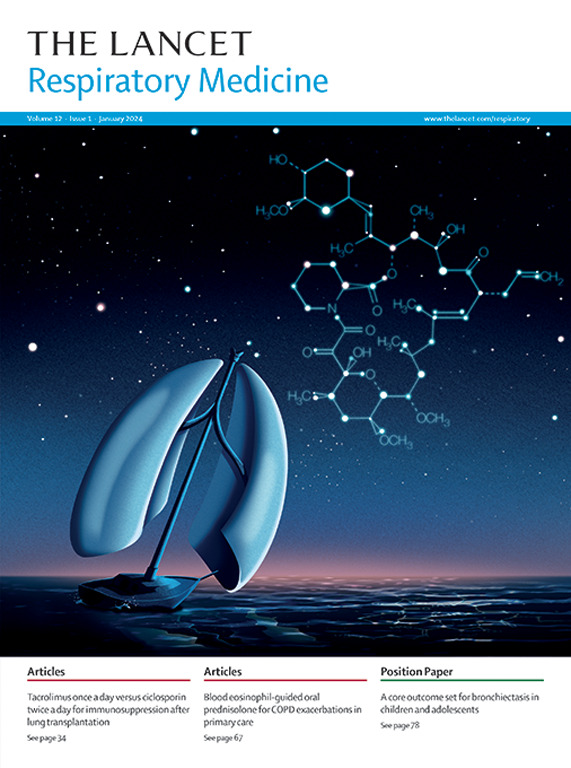Assessment of the role of small airway dysfunction in relation to exacerbation risk in patients with well controlled asthma (ATLANTIS): an observational study
IF 32.8
1区 医学
Q1 CRITICAL CARE MEDICINE
引用次数: 0
Abstract
Background
Recent surveys suggest that asthma remains inadequately controlled in more than 50% of adults with asthma despite guideline-based standard therapy. Small airways are often under-recognised as major sites of airway obstruction and inflammation. This might be related to lack of assessment with current tools such as impulse oscillometry, and thus under-treatment might explain inadequate control. Small airway dysfunction, which is common in adults with well controlled asthma, might represent an important biomarker of future risk of exacerbations. We aimed to investigate whether small airway dysfunction is present in patients with well controlled asthma and, if so, whether it is a risk factor for future exacerbations in this population.Methods
The observational Assessment of Small Airways Involvement in Asthma (ATLANTIS) study included 773 extensively characterised patients with asthma aged 18–65 years from 29 primary and specialty clinics in nine countries from June 30, 2014, to March 3, 2017. Patients were required to be diagnosed with asthma at least 6 months before inclusion based on evidence of airway hyper-responsiveness, bronchodilator reversibility, or peak expiratory flow variability. Patients were required to have stable asthma, defined as no asthma exacerbations and regular asthma treatment at a consistent dose for 8 weeks before baseline visits. The current analysis included patients with well controlled asthma, defined as an Asthma Control Questionnaire (ACQ-6) score of less than 0·75 at baseline. Small airway dysfunction was defined, based on deviation from predicted values of impulse oscillometry parameters, as a Z score of more than 1·645 for R5–R20 (resistance at 5 Hz minus resistance at 20 Hz) and AX (area of reactance) and a Z score of less than –1·645 for X5 (reactance at 5 Hz), with additional analyses exploring severe small airway dysfunction (Z score of 3 or –3). ATLANTIS is registered with ClinicalTrials.gov, NCT02123667.Findings
Of 773 patients, ACQ-6 assessments were available for 772 patients. Among these patients, 384 (50%) were classified as having well controlled asthma, and small airway dysfunction was present in 108 (36% [95% CI 30–41]) of 304 patients with impulse oscillometry data available for R5–R20, 89 (34% [28–42]) of 261 patients with data for AX, and 79 (26% [21–31]) of 303 patients with data for X5. In the multivariable analysis, we found that R5–R20-defined small airway dysfunction was associated with increased risk of future exacerbations, independent of age, sex, smoking status, Global Initiative for Asthma steps 4–5, previous exacerbations, percentage of predicted FEV1, ratio of residual volume to total lung capacity, and peripheral blood eosinophil count (hazard ratio [HR] 2·26 [95% CI 1·05–4·85]; p=0·038), whereas AX (2·07 [0·91–4·70]; p=0·082) and X5 (0·86 [0·33–2·21]; p=0·75) were not associated with exacerbations. For severe small airway disease, both R5–R20 (HR 2·80 [95% CI 1·26–6·26]; p=0·012) and AX (2·51 [1·04–6·04]; p=0·041) became independent predictors of future exacerbations, whereas X5 remained non-significant (0·99 [0·29–3·32]; p=0·98).Interpretations
We have addressed an undervalued trait by showing that small airway dysfunction is a common, sensitive, early independent risk biomarker for future exacerbations in adults with well controlled asthma.Funding
Chiesi Pharmaceuticals and the Dutch Ministry of Health.在控制良好的哮喘患者(ATLANTIS)中,评估小气道功能障碍与加重风险相关的作用:一项观察性研究
最近的调查显示,尽管有基于指南的标准治疗,50%以上的成人哮喘患者的哮喘仍未得到充分控制。小气道常被低估为气道阻塞和炎症的主要部位。这可能与缺乏现有工具(如脉冲振荡测量法)的评估有关,因此治疗不足可能解释了控制不足。小气道功能障碍在哮喘控制良好的成人中很常见,可能是未来哮喘恶化风险的重要生物标志物。我们的目的是调查控制良好的哮喘患者是否存在小气道功能障碍,如果存在,这是否是该人群未来病情恶化的危险因素。方法观察性评估哮喘小气道累及(ATLANTIS)研究纳入了2014年6月30日至2017年3月3日期间来自9个国家29个初级和专科诊所的773例年龄在18-65岁的哮喘患者。根据气道高反应性、支气管扩张剂可逆性或呼气流量变异性的证据,患者需要在纳入前至少6个月被诊断为哮喘。患者需要有稳定的哮喘,定义为没有哮喘恶化,在基线就诊前8周定期接受一致剂量的哮喘治疗。目前的分析包括控制良好的哮喘患者,定义为哮喘控制问卷(ACQ-6)评分低于0.75。根据脉冲振荡测量参数预测值的偏差,将小气道功能障碍定义为R5-R20 (5 Hz阻力- 20 Hz阻力)和AX(电抗面积)的Z分数大于1·645,X5 (5 Hz电抗)的Z分数小于-1·645,并进一步分析探索严重的小气道功能障碍(Z分数为3或-3)。ATLANTIS已在ClinicalTrials.gov注册,注册号为NCT02123667。在773例患者中,772例患者进行了ACQ-6评估。在这些患者中,384例(50%)被归类为控制良好的哮喘,304例R5-R20患者中有108例(36% [95% CI 30-41])存在小气道功能障碍,261例AX患者中有89例(34%[28-42]),303例X5患者中有79例(26%[21-31])存在小气道功能障碍。在多变量分析中,我们发现r5 - r20定义的小气道功能障碍与未来加重风险增加相关,独立于年龄、性别、吸烟状况、全球哮喘行动计划步骤4-5、既往加重、预测FEV1百分比、残气量与总肺活量之比和外周血嗜酸性粒细胞计数(危险比[HR] 2.26 [95% CI 1.05 - 4.85]; p= 0.038),而AX (2.07 [0.91 - 0.70]; p= 0.082)和X5 (0.86 [0.33 - 2.21];P = 0.75)与急性加重无关。对于严重的小气道疾病,R5-R20 (HR 2.80 [95% CI 1.26 - 6.26]; p= 0.012)和AX (HR 2.51 [1.04 - 6.04]; p= 0.041)成为未来病情恶化的独立预测因子,而X5仍无显著意义(0.99 [0.29 - 3.32];p= 0.98)。解释:我们通过表明小气道功能障碍是控制良好的成人哮喘未来恶化的常见、敏感、早期独立风险生物标志物,解决了一个被低估的特征。资助chiesi制药公司和荷兰卫生部。
本文章由计算机程序翻译,如有差异,请以英文原文为准。
求助全文
约1分钟内获得全文
求助全文
来源期刊

Lancet Respiratory Medicine
RESPIRATORY SYSTEM-RESPIRATORY SYSTEM
CiteScore
87.10
自引率
0.70%
发文量
572
期刊介绍:
The Lancet Respiratory Medicine is a renowned journal specializing in respiratory medicine and critical care. Our publication features original research that aims to advocate for change or shed light on clinical practices in the field. Additionally, we provide informative reviews on various topics related to respiratory medicine and critical care, ensuring a comprehensive coverage of the subject.
The journal covers a wide range of topics including but not limited to asthma, acute respiratory distress syndrome (ARDS), chronic obstructive pulmonary disease (COPD), tobacco control, intensive care medicine, lung cancer, cystic fibrosis, pneumonia, sarcoidosis, sepsis, mesothelioma, sleep medicine, thoracic and reconstructive surgery, tuberculosis, palliative medicine, influenza, pulmonary hypertension, pulmonary vascular disease, and respiratory infections. By encompassing such a broad spectrum of subjects, we strive to address the diverse needs and interests of our readership.
 求助内容:
求助内容: 应助结果提醒方式:
应助结果提醒方式:


